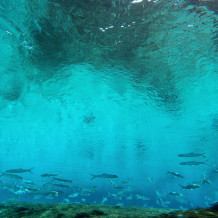know your springshed
Silver Glen Springs
When I was young my parents took us kids to Silver Springs where we rode on one of the iconic glass-bottom boats. We learned from our tour guide that the water pouring out of the spring came underground all the way from the Smokey Mountains of North Carolina. Of course he was dead wrong, but along with just about everybody else, I believed this for some years. Many people still do.
This persistent myth shows that people had a sense that Silver Springs had a watershed, where rainfall gathered and began its underground journey to the spring. We now have a more realistic, if less romantic, view of spring watersheds. We know that it is local rainfall, not water from a far-away Shangri-La, which nourishes our springs.
I first heard the word springshed from Jim Stevenson of the FDEP, that great crusader for spring protection. I grew to like Jim’s new word because it highlights the important distinction between surface (watershed) and underground (springshed) drainage systems. And, more importantly, it underscores the intimate connection between a spring and the area it drains, the paramount concept behind spring protection. You protect springs by protecting their springshed.
A springshed, or spring recharge basin, is the area of land that gathers the rainwater that discharges from a spring. The concept is simple, but the actual delineation of a springshed is usually not, for several reasons.
First, the necessary information may not be sufficient for an accurate delineation. The most basic tools are groundwater level and potentiometric surface maps, which show the direction water flows underground. These maps are based on the measurements of the water surface in wells. In many sparsely populated areas there are so few wells that the maps lack detail, making springshed boundary mapping problematic. It would be like trying to produce a conventional contour map of an entire county with just a few elevation measurements. This site details the process whereby the USGS estimated several springshed boundaries in north central Florida, including Silver Glen Spring.
Second, springshed boundaries are not static, and change with season, climate, variations in regional rainfall, and groundwater pumping. For example, the massive groundwater pumping in northeast Florida (Jacksonville and Fernandina) is reported to have shifted the regional groundwater divide, between the St. Johns and Suwannee River Water Management Districts, many miles to the west.
Third, groundwater divides may not coincide with surface water divides, complicating the reckoning of where surface water goes once it makes its way underground. Dye trace studies in Missouri have shown that underground streams can flow under hills and valleys and emerge, quite surprisingly, in distant watersheds.
The upshot of all this is that the farther we travel from a spring towards the springshed boundaries the less certain we are of our science; the interior of the basin is predictable, but, because the edges are difficult to identify, we are less sure of what is really going on out there.
The uncertainty of springshed boundaries matters because it complicates land use planning for water supply and water quality protection. The drying up of White Sulfur Spring on the Suwannee River is a case in point.
Historically, this was a perennial spring, but in the 1990’s it began to falter and now does not flow at all. There are two prime suspects; Jacksonville and its groundwater pumping and the Occidental Corporation’s giant Suwannee River phosphate mining operation. As mentioned above, the groundwater divide has shifted west to the vicinity of the spring, and the timing of this shift seems to coincide with the spring’s demise. But, has Jacksonville’s pumping, fifty miles to the east, dried up the spring, or have groundwater withdrawals at the nearby Occidental mine, just a few miles to the west, done the spring in? Do both entities share the blame? Scientists are studying the problem, but the issue is confounded by springshed margin uncertainty.







